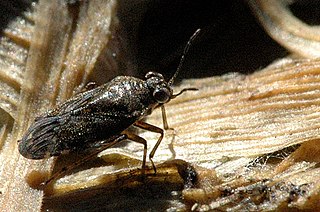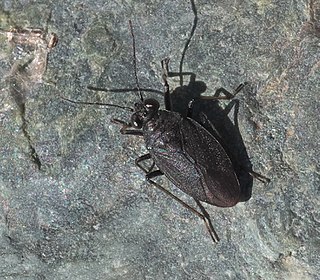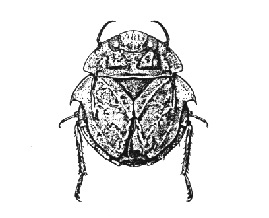
Nepidae is a family of exclusively aquatic Heteropteran insects in the order Hemiptera. They are commonly called water scorpions for their superficial resemblance to scorpions, due to their raptorial forelegs and the presence of a long slender process at the posterior end of the abdomen, resembling a tail. There are 14 genera in the family, in two subfamilies, Nepinae and Ranatrinae. Members of the genus Ranatra, the most widespread and species-rich genus, are sometimes called needle bugs or water stick insects as they are slenderer than Nepa.

Saldidae, also known as shore bugs, are a family of insects in the order Hemiptera. They are oval-shaped and measure 2–8 mm (0.08–0.31 in) when mature. Typically they are found near shorelines or the marginal growths near freshwater bodies, estuaries, and sea coasts. They can flee by leaping or taking flight. There are about 350 recognized species with the majority from the Nearctic and Palearctic. Many species are found in the intertidal zone and both adults and nymphs of some species like Saldula pallipes can tolerate submergence at high-tide. Saldidae are predators and scavengers. They pass the winter through egg or adult diapause.

Naucoridae is a small family of insects commonly known as the creeping water bugs and saucer bugs. They are similar in appearance and behavior to Belostomatidae, but considerably smaller, at 0.5–2 cm (0.2–0.8 in) long. Naucoridae are found around the world, but the greatest diversity is in tropical regions. They inhabit a wide range of freshwater habitats, ranging from still waters like ponds, to flowing rivers and even torrential streams. There are about 400 species in 46 genera in 8 subfamilies.

Ted Polhemus is an American anthropologist, writer, and photographer who lives and works on England's south coast. His work focuses on fashion and anti-fashion, identity, and the sociology of style and of the body – his objective, to explore the social and communicative importance of personal expression in style. He has written or edited more than a dozen books, and has taken many of the photographs that appear in them. He was the creator and curator of an exhibition, called "StreetStyle", at the Victoria & Albert Museum in London. One of his most popular books is "Streetstyle: From Sidewalk to Catwalk", which he originally wrote as the book for the exhibition. Ted Polhemus wrote an updated version of Streetstyle, which PYMCA published in 2010.In 2011 he published a revised and expanded version of his early book Fashion & Anti-fashion. Most recently, he has been exploring the social and cultural impact of the baby boom generation and this has culminated in the publication in 2012 of BOOM! – A Baby Boomer Memoir, 1947-22.

Water treaders, the superfamily Mesovelioidea, are insects in the order Hemiptera, the true bugs. They are semiaquatic insects that live in moist and wet habitat and on wet plant matter in several types of aquatic habitat.
Saicella is a genus of assassin bugs endemic to Hawaii. There are currently six species in the genus. Saicella's taxonomic position is uncertain, with characters similar to both the Saicinae and Emesinae subfamilies.

Belostoma is a genus of insects in the hemipteran family Belostomatidae, known colloquially as giant water bugs. Members of this genus are native to freshwater habitats in the Americas, with the greatest species richness in tropical South America. Most species in the family Belostomatidae have historically been included in Belostoma, but several of these have been moved to other genera. 9 species are claimed to be found in Northern America, but the genus Belostoma is actually divided into 16 subgroups containing about 70 species.

Mesovelia is a genus of water treaders in the family Mesoveliidae. There are more than 30 described species in Mesovelia.

Mesoveliidae is a family of water treaders in the order Hemiptera. There are about 16 genera and at least 50 described species in Mesoveliidae.

Pentacora is a genus of shore bugs in the family Saldidae. There are about 12 described species in Pentacora.

Saldula is a genus of shore bugs in the family Saldidae. There are at least 120 described species in Saldula.

Ambrysus is a genus of creeping water bugs in the family Naucoridae. There are more than 90 described species in Ambrysus.

Rheumatobates is a genus of water striders in the family Gerridae. There are more than 30 described species in Rheumatobates.
Ioscytus is a genus of shore bugs in the family Saldidae. There are about seven described species in Ioscytus.

Ochterus is a genus of velvety shore bugs in the family Ochteridae. There are more than 70 described species in Ochterus.
Platyvelia is a genus of smaller water striders in the family Veliidae. There are about nine described species in Platyvelia.

Leptopodidae is a family of spiny-legged bugs in the order Hemiptera. There are about 15 genera and more than 40 described species in Leptopodidae.

Hermatobates is a genus of wingless marine bugs placed as the sole genus in the family Hermatobatidae that are sometimes known as coral-treaders. They are quite rare and known only from coral reefs in the Indo-Pacific region. During low tide, they move over the water surface not unlike the more familiar water-striders around coral atolls and reefs and stay submerged in reef crevices during high tide.
Sagocoris is a genus of true bugs belonging to the family Naucoridae.
Darwinivelia is a genus of true bugs belonging to the family Mesoveliidae.













